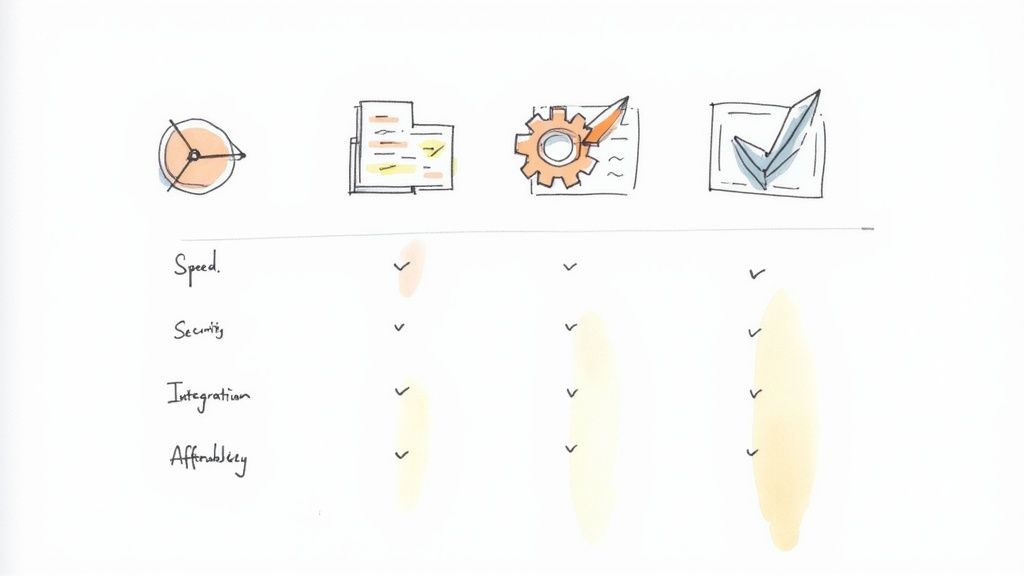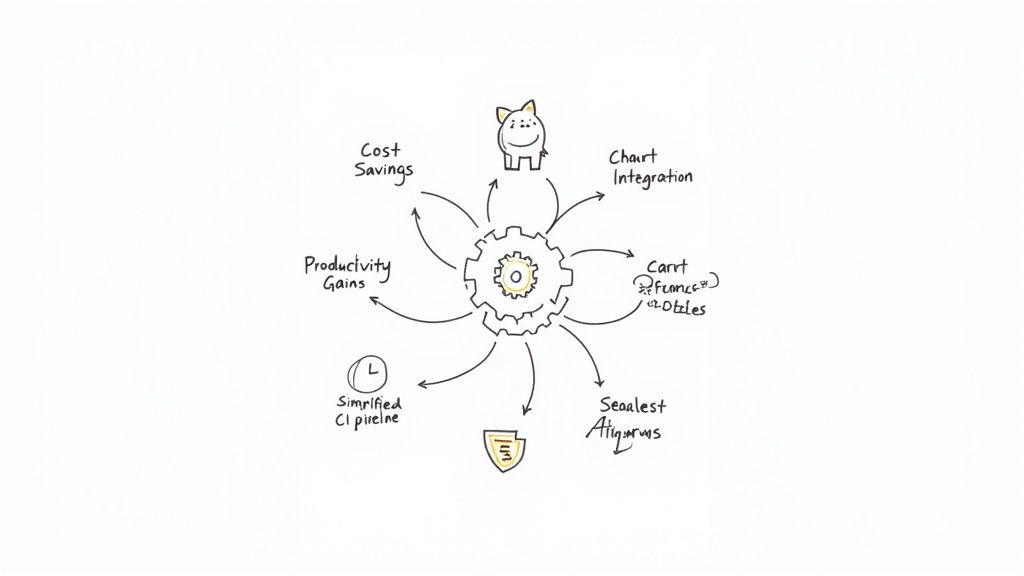The Critical Importance of Software Testing: Building Quality Through Smart Strategy

The Modern Evolution of Software Testing

Software testing has evolved from being an afterthought to becoming an essential part of the software development lifecycle (SDLC). Rather than just checking for bugs after development, testing now happens continuously throughout the development process. The growing importance of testing is reflected in the numbers - the software testing market reached $45 billion in 2022 and is expected to grow 5% annually through 2032 as more companies prioritize quality assurance.
From Bug Detection to Strategic Advantage
In the early days, software testing focused mainly on finding and fixing bugs after development was complete. This reactive approach often led to expensive fixes and project delays. According to IBM's Systems Sciences Institute, addressing defects after release can cost up to six times more than fixing them during development.
Today's approach is much more proactive and strategic. Testing starts from the initial requirements gathering phase and continues through deployment. By building quality checks into every stage, teams can prevent issues before they occur. This shift has made testing a key driver of business success by enabling faster releases, lower costs, and better customer experiences.
Balancing Automation and Human Expertise
While automated testing tools have made testing faster and more efficient, especially for repetitive tasks, manual testing remains vital. Human testers are essential for exploratory testing, evaluating usability, and scenarios that require judgment and intuition.
The most effective testing strategies combine both automated and manual approaches. Teams use automation to handle routine regression tests while relying on skilled testers for creative exploration and critical analysis. This balanced methodology ensures thorough testing coverage while making the best use of both automated tools and human capabilities.
Prioritizing Tests for Maximum Impact
As software grows more complex, trying to test everything becomes impractical and costly. Risk-based testing helps teams focus their efforts on the most critical areas. By identifying essential features, commonly used functions, and components with a history of issues, teams can test more efficiently.
For instance, when testing a banking application, the team might focus intensively on security features and transaction processing while doing lighter testing on visual elements. This targeted approach helps prevent critical defects from reaching users while making the best use of testing resources. Risk-based testing turns quality assurance into a strategic tool that aligns directly with business goals.
Smart Money: The Business Case for Early Testing

Testing early in software development isn't just good engineering practice - it makes solid business sense. When testing is woven throughout the development process, organizations see real cost savings and higher profits. Let's explore why investing in early testing is a smart financial decision that shapes development strategy and resource planning.
Quantifying the Cost of Defects
Finding and fixing bugs after software release can seriously hurt your bottom line. According to research from IBM's Systems Sciences Institute, fixing a bug after release costs about six times more than catching it during development. Why such a big difference? Post-release fixes mean stopping normal operations, rushing out emergency patches, managing upset customers, and sometimes even legal issues. A bug that takes a developer a few hours to fix during coding could end up costing thousands in lost revenue and damage control if discovered after release. The math is clear - early testing prevents these expensive fire drills.
Optimizing the Testing Budget
Smart testing budget management helps maximize returns on quality assurance investments. Most companies spend 15-25% of their project budget on testing - for every $100 in development costs, $15-25 goes to quality checks. While this might seem like a lot upfront, it prevents much more expensive problems later. By sticking to this budget range and focusing testing on the highest-risk areas (as we covered earlier), teams can deliver quality software on time and within budget. The key is viewing testing costs as an investment in preventing future headaches, not just another expense.
Building a Strong Business Case for Testing
To get buy-in for thorough testing, focus on the bottom-line benefits. Show exactly how early testing prevents costly post-release issues. For example, compare the price tag of implementing preventive testing versus the potential losses from a major production bug - including downtime costs, lost customers, reputation damage, and emergency fix resources. Real numbers make the case compelling.
Don't forget the positive side either - high-quality, reliable software makes customers happy and keeps them coming back. You can measure this through customer retention rates, positive reviews, and increased sales. These metrics help justify investing in quality.
By highlighting both the financial savings from preventing problems and the business benefits of delivering great software, organizations can make a clear case for prioritizing testing throughout development. This proactive approach to quality protects both profits and reputation in the long run.
Risk-Based Testing: Getting Smart About Quality
Testing well requires making smart choices about where to focus your efforts. Rather than attempting to test everything equally, risk-based testing helps teams identify and prioritize the most critical areas that could impact users and business success. This focused approach leads to better results with the resources you have available.
Identifying and Assessing Risks
The first step is spotting potential risks by examining several key factors:
- Technical Complexity: Code involving intricate integrations or new technologies naturally carries more risk. For example, adding a new payment system to an e-commerce site requires especially careful testing due to its complexity.
- Business Criticality: Core features that directly affect users and revenue need thorough testing. A small bug in user login could be far more damaging than one in a rarely-used admin tool.
- Historical Data: Past issues and user feedback highlight trouble spots. If a particular feature has caused problems before, it deserves extra attention during testing.
- Usage Frequency: The more users interact with a feature, the more important thorough testing becomes. A main screen used by millions daily needs more testing than a back-office report viewed occasionally.
After identifying risks, assess each one based on how likely it is to occur and its potential impact. Here's a simple matrix for categorizing risks:
| Risk Level | Likelihood | Impact |
|---|---|---|
| Critical | High | High |
| High | Medium | High |
| Medium | High | Medium |
| Low | Medium | Medium |
Building a Risk-Based Testing Strategy
With risks assessed, create a testing plan that focuses on high-priority areas:
- Test Case Prioritization: Build and run tests for critical features first. This ensures the most important functionality gets thorough testing, even with limited time and resources. Less critical areas can be tested later or less extensively.
- Resource Allocation: Match your testing resources to risk levels. Put more time and effort into high-risk areas while maintaining basic coverage elsewhere. This helps use resources wisely.
- Test Coverage: While focusing on risks, maintain reasonable coverage across all areas. For instance, security testing might be top priority, but basic usability testing still matters too.
Benefits of Risk-Based Testing
This focused testing approach offers several key advantages:
- Early Bug Detection: Finding critical issues early in development saves time and money on fixes.
- Reduced Costs: Smart resource use and early problem detection lower overall testing expenses.
- Improved Quality: Concentrating on crucial areas leads to better software quality overall.
- Faster Time to Market: More efficient testing helps teams release software sooner.
- Increased ROI: Preventing expensive post-release problems while speeding up delivery improves the return on testing investments.
Risk-based testing isn't about doing less testing - it's about testing smarter by focusing on what matters most. This approach helps teams be proactive about quality while supporting business goals and user needs. In the next section, we'll explore how to integrate testing throughout development for even better results.
Integrating Testing Throughout Your Development Lifecycle

Software testing isn't just a final checkpoint - it needs to be woven into every stage of development, from initial planning through deployment. When teams make testing an ongoing priority rather than an afterthought, they catch issues earlier and build better software.
The Shift-Left Approach: Testing Early and Often
Getting testing started early is known as the "shift-left" approach. Rather than waiting until code is complete, testing begins during requirements gathering and design. This helps catch potential problems when they're still small and manageable. For example, identifying unclear requirements early prevents them from turning into major architectural flaws down the road.
Continuous Testing in Agile Environments
In agile development, where teams work in short sprints, testing needs to happen continuously. Each sprint should include dedicated testing time to verify new features work properly and don't break existing functionality. This steady focus on testing prevents issues from piling up and maintains a stable codebase.
Different Strokes for Different Folks: Adapting to Your Development Methodology
Testing approaches need to match your development process. Waterfall projects often work best with structured testing phases, while agile teams benefit from ongoing testing and automation. The key is finding testing practices that fit your team's specific workflow and needs.
Building a Culture of Quality Through Effective Test Automation
Test automation plays a vital role in continuous testing. By automating repetitive checks like regression testing, teams can focus more time on exploratory testing that requires human insight. Tools like Mergify help streamline code integration and testing processes. The goal is making quality testing a natural part of development.
The Importance of Collaboration and Communication
Creating high-quality software requires close collaboration between developers, testers and other team members. Regular communication helps everyone understand quality expectations and allows quick problem-solving when issues arise. Practices like pair testing, where developers and testers work together, improve testing effectiveness. This shared commitment to quality leads to software that is reliable, stable and delivers real value to users. Making testing a team-wide priority sets successful projects apart from those that struggle to meet user needs.
Making Testing Pay: The Economics of Quality
Software testing is more than just finding bugs - it's a critical investment that delivers real business value. When integrated throughout development, testing creates higher quality software while reducing long-term costs. Understanding this economic impact helps teams make smart decisions about where and how to invest in testing.
Calculating the Return on Investment (ROI) of Software Testing
While measuring testing ROI involves multiple factors, focusing on key metrics provides valuable insights. The main consideration is comparing testing costs against the much higher expenses of fixing issues after release. A critical bug that reaches production can trigger costly emergency fixes, system outages, lost sales, and damaged customer trust. These combined costs typically far exceed what thorough testing would have required.
Beyond just preventing problems, effective testing drives business growth through improved user experiences that boost customer retention and sales. For example, when an e-commerce site thoroughly tests its checkout flow, customers encounter fewer errors and are more likely to complete purchases. This direct connection between quality and revenue demonstrates testing's broader business impact.
Optimizing Testing Costs for Maximum Impact
To maximize returns on testing investments, teams need smart resource allocation strategies. A risk-based approach helps by directing more testing effort to features that see frequent customer use or have complex functionality. For instance, a banking app might focus extensive testing on money transfer features while giving lower priority to account preferences screens. This targeted strategy ensures the most critical functionality receives appropriate coverage.
Leveraging Automation to Increase Efficiency and Reduce Expenses
Test automation serves as a powerful tool for optimizing testing costs and boosting ROI. By automating repetitive checks like regression testing, teams free up skilled testers to focus on exploratory testing that requires human insight. Automated tests also provide rapid feedback, helping catch issues earlier when they're cheaper to fix. However, automation works best as part of a balanced strategy - while automated tests excel at verifying known requirements, manual testing remains essential for discovering unexpected issues and evaluating the overall user experience.
Demonstrating the Value of Software Testing to Stakeholders
Making the business case for testing requires showing stakeholders concrete evidence of its value. This means highlighting specific costs of production defects - like lost revenue during outages or emergency fix expenses - compared to preventive testing costs. Real examples of how testing improves metrics like customer satisfaction scores and reduces maintenance costs over time make the benefits tangible. When stakeholders understand testing as an investment that drives business results rather than just a cost center, they're more likely to support quality initiatives that benefit both products and profitability.
Future-Proofing Your Testing Strategy

Creating a solid testing strategy requires careful planning for how software development is changing. Teams need to build processes that can adapt while maintaining high quality standards. This means keeping core testing principles intact while being open to new tools and methods that emerge.
Embracing AI and Machine Learning in Testing
AI and machine learning are changing how teams approach testing. These tools help automate complex testing tasks, expand test coverage, and spot potential issues early. For instance, AI can analyze testing data to find patterns that humans might miss, making the whole process more efficient. Test teams can then focus on strategic work instead of repetitive manual testing. This makes testing both more powerful and more cost-effective within the development cycle.
The Rise of Shift-Right Testing
While teams have widely adopted shift-left testing practices, "shift-right" testing is gaining importance too. This approach focuses on testing in live environments after deployment. Teams use methods like A/B testing, gradual rollouts, and monitoring real user behavior. By watching how actual users interact with the software, teams can find performance issues and usability problems that might not show up in test environments. This practical feedback helps improve both the user experience and development process.
Building Adaptable Testing Frameworks
Success in testing depends on creating flexible frameworks that can grow and change. This means using modular test designs and reliable open-source tools. When tests are modular, teams can check individual components separately and easily update them as needed. Open-source testing tools give teams flexibility and community support without getting locked into specific vendors. It's also key to build diverse testing teams with skills in automation, performance testing, security testing, and data analysis.
Measuring Success in a Changing Landscape
While traditional metrics like defect counts and test coverage still matter, teams need new ways to measure testing success. This includes tracking user satisfaction scores and how changes affect business goals like conversion rates. Teams should also measure the business value of their testing efforts to show stakeholders why testing matters. When you can link testing work directly to better business results, it's clear how testing helps achieve company goals.
Streamline your development workflow and enhance code quality with Mergify. Its powerful automation features minimize CI costs and boost developer productivity. Learn more about how Mergify can transform your team's workflow.





